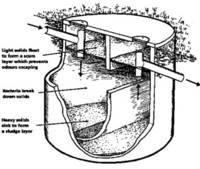Understanding Your Septic System
Your septic system is like a living stomach where bacteria do the work of digesting waste.
HOW A SEPTIC TANK WORKS

A healthy septic is a living ecosystem where the right bugs (bacteria) thrive in the right proportions to digest waste and treat the water (effluent).
Health caution: Septic tanks do not kill pathogenic bacteria, viruses or parasites. Septic tank effluent must be treated with extreme caution and contact with people, food, clothing and pets must be prevented!
The contents of a healthy septic should form 3 layers -
- A layer of fats (called "scum") which floats to the surface.
- A clear layer.
- A layer of solids (called "sludge") which sinks to the bottom.
The scum helps prevent odours escaping and stops air entering. The clear wastewater continually flows slowly out of the tank through an outlet pipe.
In most systems, the water is distributed into the ground by a system of trenches (an absorption field).
The wastewater at this stage may still contain dissolved pollutants such as salt and phosphorus, and also viruses and bacteria.
Once in the absorption field, soil bacteria breaks down pollutants like phosphorus, nitrogen, faecal bacteria, and organic food material. As this is a relatively slow process, and the soil bacteria need oxygen to work, it is important not to overwhelm the soil with too much wastewater.
Eventually the excess water evaporates from the soil, is taken up by plants growing on the absorption area or leaches into the groundwater zone.
Greywater tanks and greasetraps
Septic systems may also have a separate tank for greywater, the wastewater which comes from the kitchen, laundry and bathroom. There may also be a greasetrap, for collecting oil and grease from the kitchen. The water from the greasetrap eventually collects in the greywater tank.
Greywater treatment systems are now available if you wish to use your greywater to irrigate your garden. For information regarding accredited systems, call your local Public Health Unit (part of your Area Health Service) or Council's Environmental Health Officer.
THE DEAD POSSUM MYTH
In the old days when a new septic system was started up on a farm, a dead possum or sheep was sometimes thrown in to the new tank. Septic folklore had it that the carcass would "kickstart" the system.
In fact the sewage which starts flowing into the tank as soon as it is connected to the house provides plenty of nutrients for the bacteria to begin doing their job.
To start up a new or pumped out system, fill the tank with clean water and add a cupful of lime down the toilet every day for 7 days. This prevents odours and increases the pH (alkalinity) which encourages bacterial growth. This treatment can also be used when the septic becomes smelly.